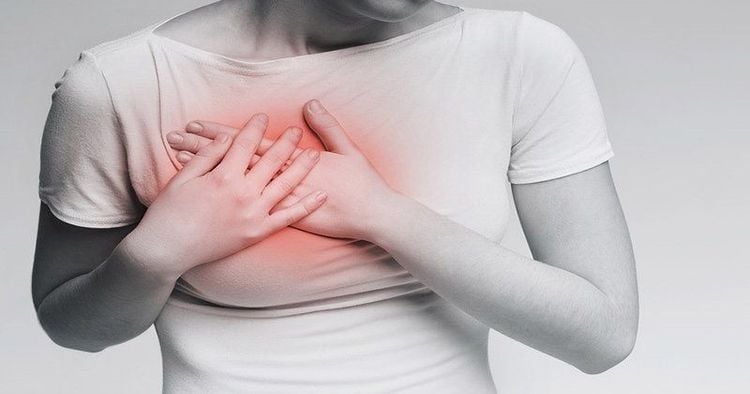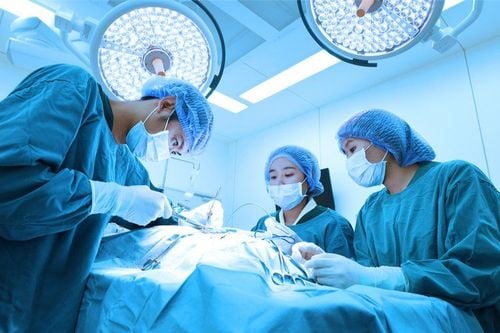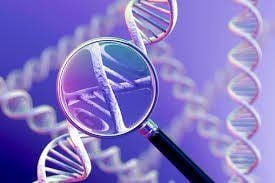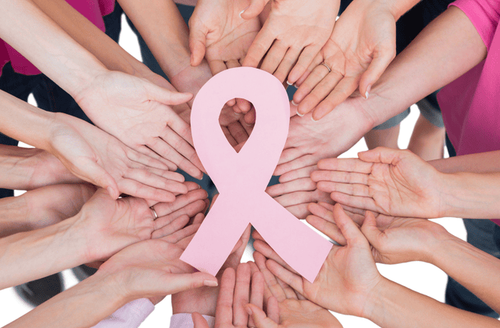This is an automatically translated article.
Breast cancer is a common type of cancer in women, occurring when the cells of the breast tissue grow rapidly and out of control. Breast cancer in women is divided into several different types, the most common being ductal carcinoma in situ. Breast cancer cells are often concentrated and form a tumor that can be seen and palpated clinically or detected only on mammography or MRI.1. The outlook for breast cancer
Breast cancer today is not the same as it was 20 years ago. The survival rate of the disease is increasing thanks to the improvement in people's consciousness, the early detection of the disease and new advances in treatment. Patients diagnosed with breast cancer today have many reasons for hope.2. Clinical picture of breast cancer
Usually, breast cancer has no obvious clinical manifestations. Some transient abnormal signs can warn of disease that patients easily miss such as:Small breast mass Change in size and shape of mammary glands Swollen axillary lymph nodes Abnormality in nipple or nipple discharge Pain Breasts can also be a symptom of breast cancer, but it's not as common.
3. Inflammatory breast cancer

Ung thư vú dạng viêm là loại ung thư vú hiếm gặp trên lâm sàng nhưng diễn tiến nhanh
4. Mammography
The earlier the disease is detected, the more likely it is to be successfully treated. Mammography is a diagnostic imaging tool that uses X-rays to examine the mammary glands. Mammography can help detect small tumors before they are clinically palpable. The American Cancer Society recommends that women 45 to 54 years of age with an average risk of breast cancer should have an annual mammogram. From age 55 and older, mammograms can be spaced out, routinely every 2 years.5. Ultrasound and MRI of the breast
Your doctor may order more tests to examine the internal structure of the mammary gland. Breast ultrasound is a non-invasive and repeatable imaging modality. Breast cancer images on ultrasound are dense tissue structures, invading surrounding and proliferating blood vessels. Magnetic resonance mammography or breast MRI combined with ultrasound for routine screening of breast cancer in high-risk individuals.6. Breast self-examination
For many years, doctors have always advised women to do regular breast self-exams every month. But more recent studies show that breast self-exams play only a small role in detecting breast cancer compared with other methods. What needs to be done is to have an overview of the mammary glands and to recognize even small changes related to the shape, size, and color of the skin instead of doing breast self-examination as before.7. What to do when a breast lump is detected?
Not panicking is the first thing to do when a breast lump is discovered. More than 80% of breast lumps are not indicative of malignancy. They are usually cysts or benign tumors, which change with the menstrual cycle. However, the patient still needs to see a doctor to determine its abnormal histological nature. If unfortunately it is cancer, the disease is also at an early stage or determining the benign nature of the breast tumor also helps the patient feel reassured.
Hơn 80% các khối u tại vú không phải là biểu hiện của bệnh lý ác tính
8. Biopsy of breast tissue
This is the only means to definitively diagnose the histological nature of the mammary gland tumor. A biopsy of the breast tissue is done by taking a tissue sample of the breast lump with a needle and looking at it under a microscope. In some cases, patients need surgery to remove the entire tumor for testing. The results of a biopsy of breast tissue indicate whether a lump is cancerous and the classification of cancer if present. Breast cancer is divided into several groups that respond to specific treatments.9. Hormone-sensitive breast cancer
Some types of breast cancer develop dependently on estrogen or progesterone. Doctors can order tests that detect the presence of receptors for each hormone, thereby determining specific treatments for each patient. About two-thirds of breast cancers are hormone-sensitive.
10. HER2(+) breast cancer
About 20% of breast cancer patients have more HER2/neu protein in their malignant cells, called HER2(+) breast cancer. This is a group of breast cancers that progress faster than other types. The identification of a breast cancer patient with HER2(+) plays an important role in choosing treatment.
11. Breast cancer stage
Once breast cancer is diagnosed, the next step to take is to determine the stage of the disease in relation to the size of the tumor and the impact on other organs. Your doctor will assign stages 1 to 4, which describe metastasis to the lymph nodes and other organs in the body such as the lungs. Knowing the stage and type of breast cancer helps in planning treatment.
12. Survival rate
Survival in breast cancer is highly dependent on when the disease is detected. The American Cancer Society states that 99% of breast cancer cases in women with stage 1 can go on for at least 5 years, and many patients in this group have the potential to make a full recovery. At stage 4, the 5-year survival rate drops sharply to 27% but this rate will improve with effective treatment.
13. Breast cancer surgery
There are different surgical methods in the treatment of breast cancer such as a mastectomy or a lumpectomy (lumpectomy). Patients should be consulted and discussed with their doctor about the risks and benefits of each method to be selected.

Có nhiều phương pháp phẫu thuật khác nhau trong điều trị ung thư vú như phẫu thuật cắt trọn tuyến vú (mastectomy) hoặc phẫu thuật cắt bỏ khối u (lumpectomy)
14. Radiation therapy in breast cancer
This treatment aims to destroy malignant cells based on high energy X-rays. Radiation therapy may be used after breast cancer surgery to kill any remaining cancer cells. This method is also combined with chemotherapy to treat when breast cancer has spread to other organs of the body. Side effects of radiation therapy in breast cancer include fatigue and burning of the skin at the treated site.
15. Chemotherapy
This treatment uses drugs to destroy malignant cells inside the body. Medicines are usually given intravenously, but some are also taken orally. Patients may receive chemotherapy before surgery to shrink the tumor or after surgery to reduce the chance of recurrence. Late-stage breast cancer in women is well controlled with chemotherapy. Side effects include hair loss, nausea, fatigue and an increased risk of infection.
16. Hormone therapy
Hormone therapy is a treatment method applied to breast cancers that have estrogen and progesterone receptors. These cancers progress rapidly in response to the hormones estrogen or progesterone. Hormone therapy against this mechanism is indicated after surgery to prevent the cancer from coming back. Sometimes hormone therapy is used as a preventive measure for breast cancer in high-risk patients.
17. Targeted treatment
This is a new treatment method that addresses specific abnormalities inside malignant cells. In cases of breast cancer with HER2 (+), targeted therapy is applied to block this protein from working and limit the growth of cancer cells. Targeted drugs are often used along with chemotherapy.18. Immunotherapy

Một số phụ nữ có nguy cơ cao mắc bệnh ung thư vú do sở hữu các đột biến gen đặc hiệu, phổ biến nhất là BRCA1 và BRCA2
Immunotherapy supports the body against breast cancer, sometimes indicated in the late stages. Marker immunosuppressive drugs target specific proteins in the immune system. This makes it difficult for cancer cells to evade attack by other treatments.
19. Patient's life after diagnosis
Having cancer is not an easy experience in every patient's life. Treatment affects many aspects other than health, such as work and social relationships. It is very easy for the patient to feel lonely. Many patients choose to join associations or organizations that support cancer patients to make them more optimistic and know that they are not alone.
20. Breast reconstruction
Many female patients after mastectomy for cancer choose breast reconstruction surgery. Skin, nipple and breast tissue are all reconstructed to look like a normal mammary gland using tissues from other body components or artificial materials. Some women start this procedure right after a mastectomy, but it's a good idea to wait a few months or years.
21. Prosthetic breasts
Instead of breast augmentation surgery, the patient can choose to use a prosthetic that is placed inside the bra. Wearing a prosthesis helps the patient have a more balanced and aesthetic appearance.
22. Why get breast cancer?
The most obvious risk factor for breast cancer is female gender. Breast cancer can still occur in men but is rarer. Breast cancer in women is about 100 times more common than breast cancer in men. Other risk factors include being over 55 years old and having a close relative with breast cancer. However, more than 80% of patients with breast cancer have no related family history.23. Genes linked to breast cancer

Một số phụ nữ có nguy cơ cao mắc bệnh ung thư vú do sở hữu các đột biến gen đặc hiệu, phổ biến nhất là BRCA1 và BRCA2
Some women are at increased risk for breast cancer because they have specific gene mutations, most commonly BRCA1 and BRCA2. The risk of breast cancer in these people increases throughout their life stages.
24. Reduce the risk of breast cancer
Women who breastfeed for at least 6 months to 2 years can reduce the risk of developing breast cancer by about 25%. Maintaining a healthy weight with a low BMI and exercising regularly are ways to reduce the risk of disease. Limiting alcohol intake is also a beneficial measure. Birth control pills and some hormone replacement treatments after menopause may promote a reduction in risk, but the chance of getting the disease increases again when you stop taking it.
25. Breast cancer studies
Many doctors are still researching treatments that are easier to apply and more effective. Support for these studies comes from a variety of sources from many countries around the world. More than 3.1 million breast cancer survivors and their families decide to participate in fundraising events such as marathons. This helps bring individuals together in the fight against cancer.At Vinmec International General Hospital, there is a Breast Cancer Screening Package to help detect breast cancer early even when there are no symptoms.
Breast cancer screening package at Vinmec for the following subjects:
Female customers, over 40 years old. Customers wishing to be able to screen for breast cancer Customers are at high risk of cancer – especially customers with a family history of breast cancer. Women of reproductive age, perimenopause and menopause. Women who are having symptoms of breast cancer such as: pain in the breast, lump in the breast, etc. >> See more: Nutrition to support breast cancer patients - Article by Dietitian Dietitian Bui Van Dien - Vinmec Times City International General Hospital
Please dial HOTLINE for more information or register for an appointment HERE. Download MyVinmec app to make appointments faster and to manage your bookings easily.
Article reference source: webmd.com












